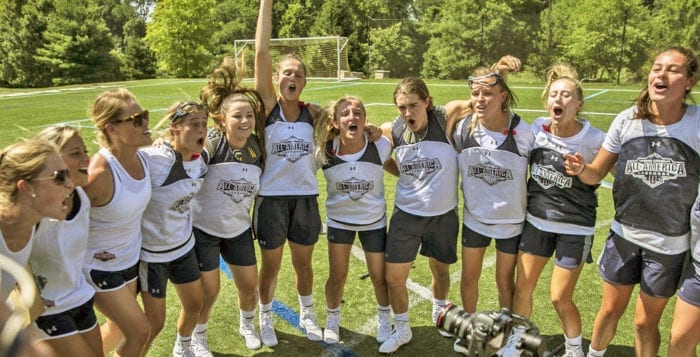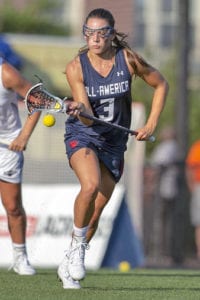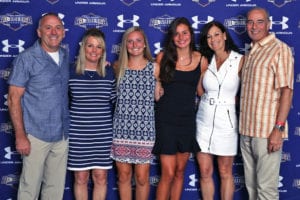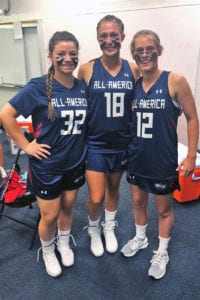Theatre Three, 412 Main St., Port Jefferson will hold an open cast call for strong singer/actor/dancers (ages 16 and up) on Tuesday, July 10 and Monday, July 16 at 7 p.m. for its upcoming production of “The Addams Family.” Prepare 16 bars from the song of your choice; bring sheet music in the proper key and be prepared to dance. Readings will be from the script. Please bring picture/résumé. Performances will be held from Sept. 16 to Oct. 27. For further information, call 631-928-9202 or visit https://theatrethree.com/auditions.html.
Yearly Archives: 2018
Historical photos of Port Jefferson wanted
Help preserve history! The Port Jefferson Village Archive department, located on the second floor of the Village Center, 101A East Broadway, is seeking old photos of Port Jefferson from the 1920s, 1930s and 1940s. Photos will be returned after they have been scanned. For additional details, call Chris Ryon at 631-802-2165.
Medical Compass: Declare your independence from poor health
Preventing diabetes, cancer and stroke
By David Dunaief, M.D.

What better way than a season centered around eating al fresco to kick-start you on the path to preventing chronic diseases? In the past, I have written about the dangers of processed meats in terms of causing chronic diseases, such as cancer, diabetes, heart disease and stroke. These are foods commonly found at barbecues and picnic meals. Therefore, I think it is only fair to talk about healthier alternatives and the evidence-based medicine that supports their benefits.
The Mediterranean-style diet is the key to success. It is composed of thousands of beneficial nutrients that interact with each other in a synergistic way. This particular diet, as I have mentioned in previous articles, includes fish, green leafy vegetables, fruit, nuts and seeds, beans and legumes, whole grains and small amounts of olive oil. We all want to be healthier, but doesn’t healthy mean tasteless? Not necessarily.
At a memorable family barbecue, we had a bevy of choices that were absolutely succulent. These included a three-bean salad, mandarin orange salad with raspberry vinaigrette, ratatouille with eggplant and zucchini, salmon filets baked with mustard and slivered almonds, roasted corn on the cob, roasted vegetable and scallop shish kebobs and a large bowl of melons and berries. I am drooling at the memory of this buffet. Let’s look at the scientific evidence.
Cancer studies
Fruits and vegetables may help prevent pancreatic cancer. This is very important, since by the time there are symptoms, the cancer has spread to other organs and the patient usually has less than 2.7 years to live (1). Five-year survival is only 5 percent (2). In a case control (epidemiological observational) study, cooked vegetables showed a 43 percent reduction and noncitrus fruits showed an even more impressive 59 percent reduction in risk of pancreatic cancer (3). Interestingly, cooked vegetables, not just raw ones, had a substantial effect.
Garlic plays an important role in reducing the risk of colon cancer. In the IOWA Women’s Health Study, a large prospective (forward-looking) trial involving 41,837 women, there was a 32 percent reduction in risk of colon cancer for the highest intake of garlic compared to the lowest. Vegetables also showed a statistically significant reduction in the disease as well (4). Many of my patients find that fresh garlic provides a wonderful flavor when cooking vegetables.
Diabetes studies — treatment and prevention
Fish plays an important role in reducing the risk of diabetes. In a large prospective study that followed Japanese men for five years, those in the highest quartile of intake of fish and seafood had a substanttial decrease in risk of Type 2 diabetes (5). Smaller fish, such as mackerel and sardines, had a slightly greater effect than large fish and seafood in potentially preventing the disease. Therefore, there is nothing wrong with shrimp on the “barbie” to help protect you from developing diabetes.
Nuts are beneficial in the treatment of diabetes. In a randomized clinical trial (the gold standard of studies), mixed nuts led to a substantial reduction of hemoglobin A1c, a very important biomarker for sugar levels for the past three months (6). As an added benefit, there was also a significant reduction in LDL, bad cholesterol, which reduced the risk of cardiovascular disease. The nuts used in the study were raw almonds, pistachios, pecans, peanuts, cashews, hazelnuts, walnuts and macadamias. How easy is it to grab a small handful of unsalted raw nuts, about 2 ounces, on a daily basis to help treat diabetes?
Stroke
Olive oil appears to have a substantial effect in preventing strokes. The Three City study showed that olive oil may have a protective effect against stroke. There was a 41 percent reduction in stroke events in those who used olive oil (7). Study participants, who were followed for a mean of 5.2 years, did not have a history of stroke at the start of the trial. Though these are promising results, I would caution use no more than one tablespoon of olive oil per day, since there are 120 calories in a tablespoon.
It is not difficult to substitute the valuable Mediterranean-style diet for processed meats or at least add them to the selection. This plant-based diet offers a tremendous number of protective elements in the prevention of many chronic diseases. So this Independence Day and beyond, plan to have on hand some mouth-watering healthy choices.
» A staple of the Mediterranean pantry, beans are a healthy, versatile and super affordable ingredient. Rich in antioxidants, fiber, B vitamins and iron, they are a hearty great alternative to high-fat proteins. Serve guests the following three-bean salad as a side dish at your next summer barbecue or picnic.
Three-Bean Salad
 YIELD: Makes 10 servings
YIELD: Makes 10 servings
INGREDIENTS:
1 15-ounce can of black beans
1 15-ounce can of red kidney beans
1 15-oounce can of cannellini beans
1 yellow bell pepper, chopped
½ red onion, finely chopped
¼ cup olive oil
2 tablespoons red wine vinegar or to taste
1 clove garlic, minced
1 small bunch cilantro, basil or parsley, chopped
¼ cup dill pickle, diced
¼ cup celery, chopped
Salt and pepper to taste
DIRECTIONS:
Wash and drain the beans. Transfer to large bowl. Add remaining ingredients, toss well and refrigerate for a few hours before serving.
References:
(1) Nature. 2010;467:1114-1117. (2) Epidemiol Prev Anno 2007;31(Suppl 1). (3) Cancer Causes Control. 2010;21:493-500. (4) Am J Epidemiol. 1994 Jan 1;139(1):1-15. (5) Am J Clin Nutr. 2011 Sep;94(3):884-891. (6) Diabetes Care. 2011 Aug;34(8):1706-1711. (7) Neurology. 2011 Aug 2;77(5):418-425.
Dr. Dunaief is a speaker, author and local lifestyle medicine physician focusing on the integration of medicine, nutrition, fitness and stress management.
Book Review: ‘While There’s Life …’
‘Surviving one more day in the camps was spiritual resistance.’

Reviewed by Jeffrey Sanzel
Ruth Minsky Sender’s three memoirs — “The Cage,” “To Life” and “The Holocaust Lady” — are must-reads. The books chronicle the author’s life in Europe, from before World War II, through her inhumane imprisonment in the Nazi concentration camp system, and beyond. Sender is a writer of exceptional ability: vivid, introspective and yet always accessible. I have seen her speak and she is every bit as strong and present in person as she is on the page.
Now, the East Setauket resident has a new and unusual offering, a book of poetry, with the majority of poems written while she was in the Mittelsteine Labor Camp (1944–1945). Translated from the Yiddish by Rebecca Wolpe, the poems are raw and disturbing — as they should be. But underneath many of them is her mother’s motto: “While there’s life … there is hope.”
Miriam Trinh’s well-thought-out introduction shows the importance of “Jewish poetic creativity during the Holocaust as a reaction to Nazi oppression, persecution, and annihilation,” giving context to the writing as well as insight into Sender’s work. “This poetry,” writes Trinh, “was a direct reaction to her experiences during and after the Holocaust: the loss of her prewar identity, the realization that this loss was permanent and unrecoverable and the need to construct a new, postwar identity.”
In addition to the works written while she was in the camp, there are a handful of poems that were created in the 1950s and later. They are equally as important but are taken from a different perspective. All but two of the poems were written in Yiddish (those two in Polish), first on scraps of brown paper bags stolen from the garbage, later in notebooks.
She writes, “These poems were written in little notebooks while I was incarcerated in the Nazi slave labor camp in Mittelsteine, Germany, as prisoner #55082. I wrote them while hiding in my bunk. Every Sunday, I would read them aloud to the fifty other women living with me in the room. They were my critical and faithful audience. I endeavored both to depict scenes from our life and to give everyone a little courage and the will to continue. This was how we spent our Sundays, and anyone who had bit of talent did her best to bring a little happiness into our tragic lives.”
The notebook was given to her by the Nazi commandant after the girls were forced to perform at Christmas. They were told if they didn’t perform, all 400 Jewish girls would be punished. Sender read two of her poems (“My Work Place” and “A Message for Mama”) and somehow they touched the cold-hearted, pitiless Nazi commandant who presented her with the first book to record her verses.
Each poem is a delicate work of art. Some are a dozen lines, while others run to several pages. Given the cruel nature of the subject, it is difficult to comment. Needless to say, they are all vividly descriptive and fiercely honest.
“My Friend” explains the importance of writing. “Our Day” is a single day in the camp, from dreaming to sundown, and shows, even in the brutality, the glimmer of hope. “Greetings from Afar” addresses the day-to-day evil and sadism the prisoners relentlessly faced every moment. “Separation” expresses the pain of being split from her brothers. In “At Work,” the language depicts the harshness of the factory; in the clipped lines you can hear the merciless grinding of the machines.
“A Ray of Light” is just that: the courage to aspire to liberation in the midst of misery. “The Future,” one of the most complicated, looks at liberation from a different aspect: what will become of them and, even more so, where will their anger go upon being freed? It is a breath-taking piece.
“We Need Not Their Tears” faces the issue of where to go when returning to your home is a deadly option. “Where Is Justice?” is offered in two versions: one composed in the camp and the other written many years after. Both are the horrific story of a prisoner forced to beat another prisoner, driving the girl mad. In a book of challenging pieces, it is one of the most unsettling and haunting.
A later poem (1955), “Teaching Children Yiddish” is a celebration of the language that still exists, a symbol of persistence, with education being at its heart.
“While There’s Life …” is a volume that should be read and re-read by people of all faiths. It is a portrait not just of survival but of how one woman transformed her pain in humanity’s darkest hour into art … into life.
To order your copy of ‘While There’s Life …’ visit www.yadvashem.org and choose the Shop icon.
Three WWII vets, brothers from Port Jeff to be laid to rest

By Alex Petroski
Three Port Jefferson natives and U.S. Navy veterans from World War II will be laid to rest in Port Jeff next week, and their families have extended an invitation to the community to share memories.
The Woodard boys — Randall, Merwin and Marten — will be buried at the Randall family plot at Cedar Hill Cemetery in Port Jefferson July 14 at 11:30am.
They were raised in Port Jefferson by loving parents, Madeline and Grover Woodard, and they will be honored by all three families.
Arrangements were entrusted to the Bryant Funeral Home of Setauket.
Three Village BOE revamps report cards, recommends AP Capstone

By Andrea Paldy
Amid the end-of-year festivities, Three Village school officials did not miss a beat when it came to attending to district business. At the last school board meeting before graduation, administrators outlined coming changes to the elementary report card and added rigor to the high school curriculum.
As part of the board’s policy to review programs every five years, a committee of teachers and administrators from elementary and secondary levels reviewed and revised the elementary school report card. Kathryn White, principal at W.S. Mount Elementary School, said that since the last review, there have been changes in educational philosophy and the way teachers assess students and learning behaviors. She said there has also been the introduction of new academic standards, like Common Core State Standards and the Next Generation Learning Standards, which also needed to be considered in the two-year review process.
The committee was divided into four separate subcommittees to investigate different aspects of the report card, and the district surveyed faculty and parents on its effectiveness.
New report card notes
C — Consistently exceeds expectations
M — Most times meets expectations
S — Sometimes meets expectations
Y — Not meeting expectations
The committee developed what it believes to be a more simplified format that is easier for parents to understand. Committee member Lauren Horn, a teacher at Mount Elementary, explained that simplicity comes in the form of one achievement grade for each subject. The grades will be on a four-point scale, with a 4 demonstrating work “that exceeds grade level standards.” The scale on the sixth-grade report card will go up to 4.5 to point out “exceptional” students, she said. Effort grades for learning behaviors will represent the “growth mindset” — the concept that student behavior is not set and that students have the potential to improve with continued work, Horn said.
The committee’s report noted that rather than the familiar E (Excellent), G (Good) and I (Improvement needed), these grades will be replaced with C (Consistently exceeds expectations), M (Most times meets expectations), S (Sometimes meets expectations) and Y (Not yet meeting expectations). The comment section will feature a common language for each grade level across the district, said Dawn Alexander, district special education teacher mentor. For the 11 “behaviors related to learning” at the end of the report card, teachers will put an asterisk next to behavior they want to highlight. This is to allow parents to easily see an area in which their child is exceptional or needs more work, Alexander said.
Finally, rather than assigning a Fountas and Pinnell reading level, the report card will show reading level bands, which are a “benchmark and not a grade,” said Diedre Rubenstrunk, a lead instructional technology teacher. This means students are given a reading range based on reading ability and text difficulty.
A second committee that compared two high school diploma programs recommended that the district adopt the four-year-old Advanced Placement Capstone program. This decision came after several years of researching the International Baccalaureate program, an internationally recognized high school course of study that culminates in an International Baccalaureate diploma. The committee spent the past two years comparing the programs, said Kevin Scanlon, assistant superintendent for educational services.
Both programs are rigorous college preparatory study that encourage inquiry, research, analysis and critical thinking, and require long-form writing. To receive the IB diploma, students must take courses in six areas of study — language and literature, language acquisition, individuals and society, math, science and the arts — in addition to a year-long course called Theory of Knowledge for which students write a 1,600-word essay and give an oral presentation. They also must complete a 4,000-word extended essay as well as a community service project, encompassing creativity, activity and service.
Advanced Placement Capstone program requirements
Four AP exams
AP seminar —1,200-word written report, team project, presentation
AP research — 4,000- to 5,000-word essay, presentation, oral defence
Meanwhile, the AP Capstone diploma requires four AP exams, as well as an AP seminar and an AP research class, which are each a year long. The AP seminar includes both a team project and presentation, as well as an individual 1,200-word written report. The writing requirement for AP research is a 4,000- to 5,000-word essay, a presentation and oral defense.
In the case of both the IB extended essay and the AP Capstone essay, the papers are read and graded by readers outside of the high school. Three Village educators noted that the IB extended essay was “decentralized” and not attached to a specific class, which committee members said could be a great disadvantage. They found the AP seminar and AP research courses to offer more hands-on guidance and saw the possibility of pairing the AP research class with the district’s inSTAR science research program.
According to a survey of top colleges conducted by Ward Melville’s guidance department, colleges did not look at one program more favorably than another, said Superintendent Cheryl Pedisich. However, the process of implementing IB or AP Capstone would be drastically different.
The IB program would cost considerably more in application fees — roughly $3,000 — a $7,000 candidacy fee, as well as smaller fees for registration and subjects taught. Once the district’s candidacy was accepted after two years, the district would also have to pay an annual $11,600 fee. There are also costs to cover teacher training and ongoing professional development.
The AP Capstone program would also require teacher training, but the cumulative costs would be considerably less, according to the two program websites.
Since Three Village already offers AP classes, the committee found that adopting the AP Capstone program would be “less of a cultural shift,” and easier to implement. Ward Melville principal Alan Baum said that introducing IB would require new curriculum development and grading schemes and could cause problems for scheduling, maybe even limiting students’ class options.
The committee also pointed out that though some members visited and observed Long Island IB schools, there are not as many IB schools as AP Capstone schools. With the larger number of AP Capstone schools on the Island, Three Village could be a part of a consortium that shares resources and information.
Baum said the program could be more easily adapted to the district’s needs, while still accomplishing the same goals as an IB program. He added that this could all be achieved at a much lower and more sustainable cost to Three Village.
‘RBG’ screening presented to sold-out crowd at Theatre Three
By Heidi Sutton
The film ladies of the Port Jefferson Documentary Series (PJDS) hosted a special summer screening of the blockbuster documentary “RBG” to an enthusiastic sold-out crowd at Theatre Three in Port Jefferson on June 25. Wendy Feinberg, co-director of the award-winning series, introduced the event and informed the audience that the film, which explores Supreme Court Justice Ruth Bader Ginsburg’s exceptional life and career, is now the highest grossing film from Magnolia Pictures.
Feinberg had met one of the co-directors, Julie Cohen, at last year’s PJDS screening of “American Veteran.” “When she told me she was working on a film about Supreme Court Justice Ruth Bader Ginsburg, I immediately thought, wow, she would be a great subject,” and invited Cohen to come back when the film was completed.
“The project started about 3½ years ago when myself and Betsy West, my directing and producing partner, started to notice that Ruth Bader Ginsburg was getting quite a bit of attention,” said Cohen. “We knew her story, we knew what an amazing woman she is … and we just said someone ought to make a documentary about her and why shouldn’t it be us?”
She continued, “We approached Justice Ginsburg with this idea, this ambitious plan to make a film about her life. Her answer to us essentially was ‘not yet.’ We looked carefully over her emails — we know the Justice is a woman who chooses her words very precisely and we know two words that were not in her emails were ‘no’ and ‘never’ so we decided to proceed. ”
The film had its world premiere at this year’s Sundance Film Festival and has been making the rounds ever since.
The evening was preceded by a Toast to Ruth Bader Ginsburg wine and cheese reception downstairs at Griswold’s Cafe and was followed by a Q&A with Cohen which was moderated by Tom Needham, host of “Sounds of Film” on WUSB.
Reached after the event, Feinberg said she couldn’t believe the wonderful turnout. “We knew that ‘RBG’ had already played at the Cinema Arts Centre in Huntington since early May, at the AMC Stony Brook 17, and at the Port Jefferson Cinemas, among others.” While the reception sold out in two weeks, the ticket sales on the day of the event was a record for the series. Feinberg attributed the evening’s success to the film’s subject, the political climate and the fact that Julie Cohen made a guest appearance. “What can top this?” she laughed.
“It really moved so many people — they just loved it,” added co-director Lyn Boland, “It was just very gratifying to feel the community together like that. The audience’s reaction was great and on point. It was an amazing night.”
The team at the Port Jefferson Documentary Series is now preparing for its exciting Fall 2018 series, which begins on Sept. 17 with “Love, Gilda” followed by “When Lambs Become Lions” and “Roll Red Roll,” among others. Visit www.portjeffdocumentaryseries.com for updates.
The PJDS would like to thank Theatre Three, Pindar Vineyards of Port Jefferson, Wild by Nature, Pasta Pasta, Nantuckets Restaurant, C’est Cheese, Z-Pita and La Bonne Boulangerie Bakery for making the evening possible.
Recent grads compete in Under Armour All-America game
Mount Sinai duo join Ward Melville, Northport standouts in Maryland for game of a lifetime

By Desirée Keegan
Although North fell to South in a 10-9 overtime thriller during the Under Armour All-America lacrosse game in Maryland June 30, featuring the country’s best high school seniors, recent Mount Sinai graduate Meaghan Tyrrell was just proud to have been a part of it.

“Being chosen to be part of the Under Armour game is such a huge honor because it’s the top 44 players in the country being chosen, which makes for a great game,” she said. “It was quality, competitive lacrosse, which is good to have before heading into college.”
According to Ward Melville senior Shannon Berry, another player selected for the game, the teams arrived in Baltimore Thursday, June 28, and the girls spent the first evening at the Under Armour headquarters, where they received all of their gear. The teams practiced twice on Friday before taking the field Saturday morning.
“It was crazy to talk to some of those girls over the weekend and reflect on our time as young lacrosse players, and to see how far our journey’s as lacrosse players have gone,” the Princeton University-bound
midfielder said. “All of my teammates were both incredible lacrosse players and great people. They were all extremely competitive, but also very friendly and kind.”
Tyrrell said working alongside former competition was part of what made the experience unique.
“It’s cool to get to know people that you’ve played against in school and travel lacrosse,” she said. “I think our team clicked practicing on both offense and defense.”
Tyrrell played with teammate Meaghan Scutaro, a defender headed to the University of Notre Dame, for the last time. She said it was the best way she could cap off her high school lacrosse career.
“I can’t think of any other way to say goodbye to high school lacrosse,” she said. “The game itself was so fun.”
The Syracuse University-bound attack scored twice, her second tying the game at 9-9, which is something she’d consistently done for her Mustangs girls lacrosse team across her career.

“It was a great feeling to be able to help the team,” she said. “We had an opportunity to go into overtime and be able to try and win.”
Berry totaled four ground balls and five clears, taking one shot on goal.
“The level of competition was certainly the highest I have played in so far in my career,” said Berry, who played at attack, midfield and defense during the game. “The entire experience was incredible. Under Armour and Corrigan Sports truly do an amazing job of honoring the senior athletes and giving them an unforgettable, once-in-a-lifetime experience.”
Ward Melville graduate Alex Mazzone was chosen to play in the boys game. The Georgetown University-bound defender was on the South team that toppled North 22-15.
“It was really awesome to have both a male and female to represent Ward Melville,” Berry said. “It was great knowing that both of us were there representing our community.”
Northport attack Emerson Cabrera said the athletes are treated like professionals. They’re given new sneakers, cleats, uniforms and sticks and are followed around by photographers all weekend. The game is also broadcast live, and the teams took part in a charity day, working with Harlem Lacrosse, which Cabrera said was rewarding.

She assisted on Bayport-Blue Point attack Courtney Weeks’ goal, who Cabrera said is a longtime friend of hers with whom she played club ball.
“Everyone wanted to contribute somehow to the score, I was lucky to get a dodging opportunity to create an open cut for Courtney,” she said. “This was really an experience like no other. Under Armour makes it so special for us. I’m very proud to have ended my high school career being an Under Armour All-American.”
Cabrera, along with many of her teammates from the all-star game, will continue to compete alongside one another at the collegiate level. She’ll be joining Long Beach goalkeeper Sarah Reznick and Notre Dame Prep attack Hannah Mardiney at the University of Florida in the fall where several other local alumnae currently play, like soon-to-be senior Sydney Pirreca (Mount Sinai) and sophomore Shannon Kavanagh (Smithtown East). Cabrera added that ending her high school career with this game wasn’t just an honor, but a dream come true.
“It’s been something I’ve wanted to be a part of since I was little,” she said. “All of us have played with or against each other over the years and many of us will be joining forces together in college, so it was easy for our team to mesh. The transition I’m sure will still be a little tough, but as long as we all work hard, I’m sure it’ll go well.”
Shelter Pet of the Week: Rocky
MEET ROCKY!
 This handsome man is Rocky, a 5½-year-old lab mix who is as friendly as can be. Rocky gives the best doggy kisses and he even gives hugs! Rescued from a high kill shelter in Texas, this sweetheart is now safe at Kent Animal Shelter and dreams of the day he will have a loving family. Could that be with you? Rocky comes neutered, microchipped and up to date on his vaccines.
This handsome man is Rocky, a 5½-year-old lab mix who is as friendly as can be. Rocky gives the best doggy kisses and he even gives hugs! Rescued from a high kill shelter in Texas, this sweetheart is now safe at Kent Animal Shelter and dreams of the day he will have a loving family. Could that be with you? Rocky comes neutered, microchipped and up to date on his vaccines.
Kent Animal Shelter is located at 2259 River Road in Calverton. The adoption center is open from 10 a.m. to 4 p.m. every day. For more information on Rocky and other adoptable pets at Kent, visit www.kentanimalshelter.com or call 631-727-5731.
Update: Rocky has been adopted!
Whaling Museum to host screening of ‘The Great Gatsby’
REVISITING AN OLD SPORT
As part of the Museum Movies in Huntington series, the Huntington Historical Society will present a special screening of ‘The Great Gatsby’ (1974) starring Robert Redford, Mia Farrow and Sam Waterston at the Whaling Museum, 301 Main St., in Cold Spring Harbor on Wednesday, July 11 at 7 p.m. $5 per person. Reservations are required (no walk-ins) by calling 631-427-7045.











